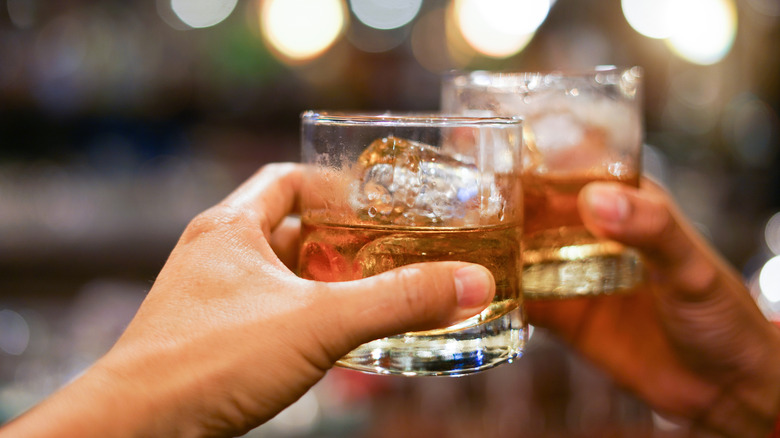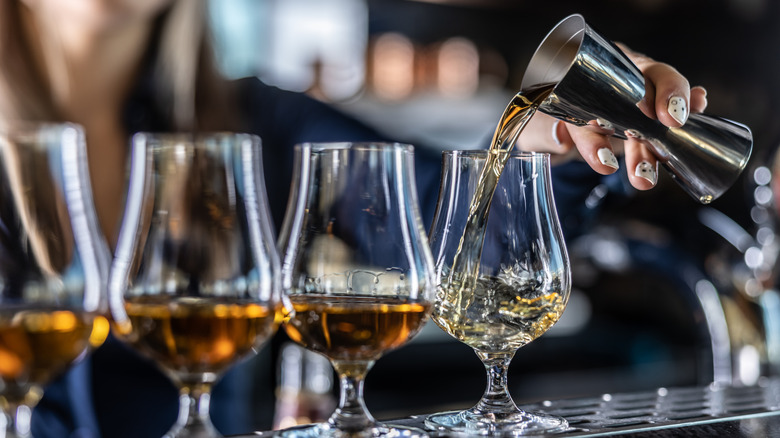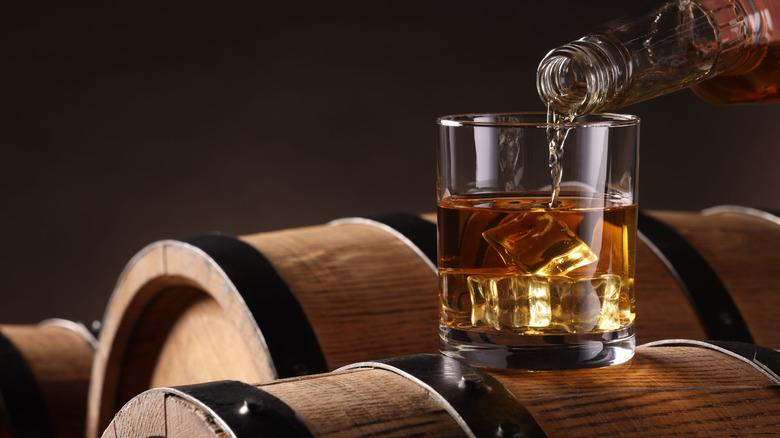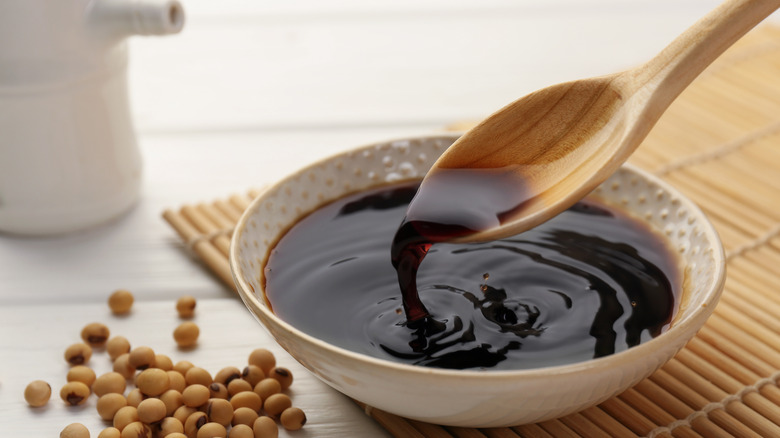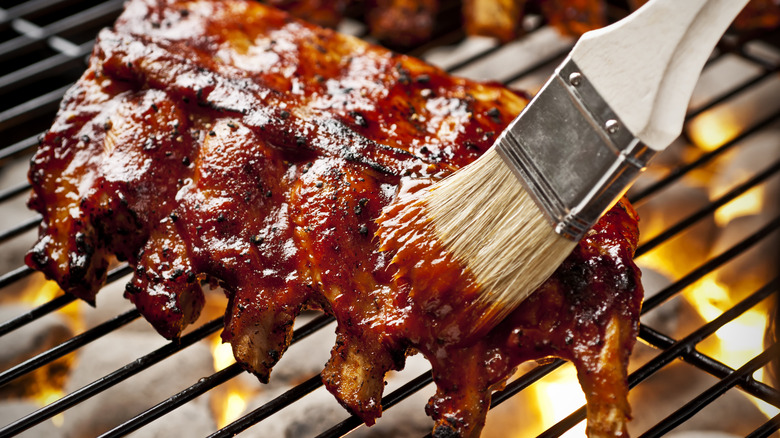12 Must-Know Tips For Making Bourbon Sauces
Look at almost any international cuisine and you'll likely find a recipe that makes use of alcohol. Wine is a staple in countless European dishes, rum cakes have been a Caribbean favorite for centuries, and the Chinese have been cooking with Shaoxing wine for over 2,000 years. The right alcohol can add unparalleled depth and complexity to a dish. Not only can it imbue a recipe with its own tasty characteristics, but it can help tenderize tough ingredients, and it's more effective at extracting flavor compounds than water or fats.
Whiskey sauce isn't an especially new invention, as it's been a feature of Scottish cuisine for some time. It was only a matter of time before someone came up with the idea of bourbon sauce. I'm a long-time bourbon-lover, and a lengthy career in the international hospitality industry has given me ample opportunities to explore and sample the whiskey style. However, it wasn't until I visited the U.S. that I had the chance to try bourbon sauce for myself. From bourbon chicken to sauce-slathered barbeque foods, I found myself ordering variations of the condiment whenever I could. When I got home, I started to experiment with making bourbon sauce myself, using my whiskey knowledge to eke out the best results. I even convinced a few venues I worked at to add a variation to their menu. Below, I'm sharing my most important tips for creating your own world-class bourbon sauce.
1. Don't cook with a bourbon would you wouldn't drink
In the culinary world, you'll often hear folks say that you shouldn't cook with a wine you wouldn't drink. When it comes to cooking with bourbon — or any kind of alcohol for that matter – the same rule applies.
Poor-quality bourbon is typically bereft of flavor and presents unpleasantly strong notes of pure ethanol. If you completely cheap out on the whiskey, your bourbon sauce will suffer. Now, that's not to say that you should be hunting down rare bottles of premium bourbon to cook with. High-end bourbon will ultimately go to waste in a sauce. It's the same principle as using fancy spirits in a cocktail — the nuances that make the bourbon unique will ultimately get lost when combined with other ingredients. Additionally, much of the bourbon will evaporate during cooking. You're better off choosing a mid-range bourbon that has enough flavor to make a tasty contribution to your sauce. Ultimately, it's a far more cost-effective option when you buy a bourbon that you'd be content to sip on while cooking. Even more important than price is suitability, and below we'll take a closer look at how to identify the best bourbon for your intended recipe.
2. The key to perfect food pairings lies in bourbon's mash bill
If you're well acquainted with the world of whiskey, then you'll know that no expression is the same. A bourbon that's well-suited to making a soft sauce for a dessert probably won't be the best choice for a sauce you intend to pair with barbequed meat. Multiple factors influence the flavor profile of whiskey, but if you want to guarantee your bourbon will pair effectively with your food, pay attention to its mash bill.
Whiskey is made by fermenting a mixture of grains and distilling the results. The type and amount of each grain used have a noticeable impact on the flavor of the final whiskey. This makes the grain recipe – which we call the mash bill — a vital aspect of whiskey-making. Bourbon's mash bill must legally contain at least 51% corn, a feature that contributes to the style's notable sweetness. The remaining 49% can be made up of countless permutations of grain combinations which will all have a different effect on the spirit's flavor. Hence, it's crucial to understand what each grain brings to the table. For example, rye is a common addition to the mash bill that contributes prominent spicy and savory notes, so a rye-forward bourbon is a better choice for a sauce paired with intensely flavored dishes. On the other hand, bourbons that heavily feature wheat are typically smoother and softer, making them a better choice when your sauce is intended for lighter foods.
3. Let the bourbon's flavor profile influence your sauce ingredients
Although it's possible to make a tasty bourbon sauce with just two ingredients, you're likely going to be relying on extra components to help it perfectly enhance your dishes. However, although different ingredients can fulfill the same role in your sauce recipe, it pays to be selective. Matching your choices to the bourbon's unique character goes a long way toward highlighting its tasty elements in your sauce.
Although a bourbon's mash bill has a strong influence on its overall flavor profile, there are other factors at hand. The distillation process, length of barrel-aging, and even the type of barrels used all play a part. Fortunately, identifying flavors in bourbon is relatively straightforward. For starters, you can always rely on the presence of vanilla and caramel notes from barrel-aging. As long as you don't pick ingredients that clash with these, you're off to a good start. Although most bourbon sauce recipes call for brown sugar, if your whiskey has honey notes, then honey will likely be a superior choice of sweetener. Conversely, a fruit-forward bourbon may benefit from maple syrup instead. A well-aged bourbon with a strong oak character may need to be combined with more intense ingredients, so they don't get overpowered by the whiskey. It's also worth remembering that a successful flavor pairing doesn't have to come from exact matching. You may get better results with contrasting flavors, but you'll still need to be able to pick out the notes to contrast against in the bourbon.
4. Keep the strength of your bourbon in mind
By law, bourbon has to be bottled at a minimum of 40% ABV (alcohol by volume). However, it can be much stronger, and there are plenty of delicious high-proof expressions available. There's nothing wrong with opting for a stronger whiskey for your sauce but it's important to know how it will impact your recipe.
Although alcohol evaporates during cooking, there's a common misconception that it will disappear entirely. Higher temperatures, longer cooking times, and larger pans will all increase how much alcohol cooks off but you'll never get that number down to zero. It's unlikely that enough alcohol will remain in your sauce to get people tipsy, but that won't stop the pungent ethanol flavor from poking through. In some cases, this can benefit a dish, but not always. If you're using a higher-proof bourbon, be aware that you may need to cook your sauce for longer to prevent it from having too much bite. You can also reduce the amount of bourbon in your recipe. Alternatively, you may want to experiment with adding the whiskey at different stages of cooking. If a lower-proof bourbon has the flavor you're after but has lost its kick after time on the stove, a last-minute splash can bring it back.
5. Use acid to balance your bourbon sauce
As I mentioned earlier, bourbon is a naturally sweet-tasting spirit thanks to its corn-dominant mash bill. This is part of what makes it such an effective sauce base but it's possible to have too much of a good thing. Left unbalanced, your bourbon sauce can taste jarringly sweet and cloying. To counter bourbon's sweetness, you'll want to add a splash of acid to your sauce recipe.
Acidic ingredients come in many forms so, once again, you'll want to base your choice on your bourbon's mash bill and flavor profile. For example, wheated bourbons are typically soft and creamy and can feature gentle tropical fruit notes, such as banana or pineapple. Therefore, you'll want to rely on light and fruity acids, such as lemon juice, apple cider vinegar, or even white balsamic vinegar. Rye-forward bourbons are bold and spicy, so a sherry vinegar or red wine vinegar are going to be better at matching the whiskey's intensity. An extra spicy bourbon may merit zippier ingredients, like lime juice or tamarind paste. High-proof bourbons will benefit from richer acids, such as balsamic vinegar, or perhaps tart, fruity acids, like cherry or pomegranate juice. Bear in mind that whatever ingredient you choose should still work with the overall character of the whiskey.
6. Utilize umami elements for extra depth
Umami is one of those flavor aspects that's simultaneously critical for a flavorsome dish but can be a little tricky to describe adequately. Umami is often incorrectly conflated with saltiness, and while many umami elements are salty, they're not the same thing. Named after the Japanese word for "delicious savory taste," umami refers to a complex, meaty aspect of food that is typically enhanced by the presence of salt.
Luckily, there are plenty of excellent umami-boosting ingredients that can effectively improve your bourbon sauce. Once again, you'll want to make sure your choice matches your bourbon and food pairing. For Asian-inspired dishes that benefit from extra saltiness, soy sauce is the obvious choice. For a smokier sauce, tangy tomato paste is a great pick. Nuttier sauces will benefit from an ingredient like miso paste, but if you're using cream as well, finely grated Parmesan is a better option. Most classic bourbon sauces are made for barbeque dishes, so a splash of tangy, slightly spicy Worcestershire sauce is perfect. Worcestershire sauce gets much of its umami-enhancing properties from anchovies. Those little fish are basically little umami bombs, so you can also blitz one or two in a food processor then add them to your sauce. If you want to up the umami without introducing any new flavors, monosodium glutamate (MSG) is the answer. MSG has unfairly gained a bad rep over the years, but it's a perfectly safe and incredibly effective ingredient you won't regret using.
7. Know the difference between bourbon sauce and bourbon glaze
Depending on the dish you're making, a bourbon glaze may be a better choice than a sauce. Technically, a glaze is still a type of sauce, but it's worth knowing what makes it different, how to make one, and why it might be a preferable option.
Compared to regular sauces, glazes are thicker with a higher concentration of flavors. While glazes can still be savory, they typically contain extra sugar which helps them adhere to the surface of food instead of pooling like a standard sauce, so you get to experience the flavor in every bite. The sugar also helps the glaze crisp and caramelize under heat, adding yet another delicious element to your dish if you apply it near the end of your food's cooking time. Although you can drizzle a glaze over your dish, a brush can help you achieve a more consistent distribution. All these features make a whiskey glaze perfect for savory dishes, like bone-in ham, or even lighter desserts, like grilled summer fruits. Plus, if you have any left over, you can keep your bourbon glaze in the fridge and it should stay good for a couple of weeks.
8. Create a bourbon reduction for more concentrated flavors
Another way to create a more intensely flavored sauce is to opt for a reduction. Although the two share some similarities, a reduction isn't quite the same as a glaze. A glaze relies on extra sugar to create a thick, gooey coating that sticks to food. A reduction requires "reducing" a sauce by simmering it for an extended period of time.
The longer you cook your sauce, the more liquid evaporates. As a result, the sauce thickens, highlighting its aromatics and causing the flavors to become much more concentrated. It's an excellent way of incorporating a tasty bourbon sauce into a dish without having to douse the food. Reductions are also ideal when your sauce uses alcohol as a base ingredient. The extra cooking time allows more alcohol to cook off, softening the sauce without compromising on the bourbon flavor. It's possible to over-reduce a sauce, so the trick is to keep an eye on it and keep tasting it. Your choice of pan is especially important when making a reduction — a large pan will increase the rate of evaporation which can make it harder to control. I find that a narrow pan is best because you'll find it easier to monitor how much of your sauce has reduced at a glance.
9. Up the intensity with barrel-aged and smoked seasonings
Many of bourbon's tastiest and most interesting flavors come from barrel-aging, another process that's a legal requirement of the whiskey style's production. Bourbon must be aged in new, charred white oak barrels. The origins of this technique are still debated. Some believe the origin of bourbon barrel-aging relates to using fire to cleanse the smell of fish from used barrels while famed distiller Elijah Craig still insists the method was invented by its namesake, a legendary bourbon-making Baptist preacher. History aside, what matters is the flavors that barrel-aging gives bourbon and how to make the most of them in a sauce.
Barrel-aging is responsible for bourbon's classic vanilla and caramel flavors, but extended maturation can result in an array of more nuanced barrel notes, like baking spices, smoke, and dried fruit. Nutty, earthy, and floral aspects are also possible with barrel-aging. The downside is that cooking with bourbon can result in the loss of the spirit's more subtle characteristics, but there's a way to bring them back into the picture. Smoked seasonings like salts, chilis, and herbs are a superb way of reviving the whiskey's charred character. You can even find bourbon barrel-aged ingredients, like maple syrup, soy sauce, and Worcestershire sauce which will amplify the barrel character in your recipe.
10. Deglaze with bourbon to enhance your sauce
Although deglazing may sound like a technical culinary technique, it's much simpler than you might think. After cooking ingredients in a pan that doesn't have a non-stick coating, you've almost certainly noticed the food debris stuck to the bottom of it. For the uninitiated, this burned-on detritus is just another headache when it's time to do the washing up. In reality, these crispy morsels can provide a huge flavor boost to your sauce, and loosening them up is pretty straightforward.
To deglaze a pan and release the caramelized food pieces — known as "fonds" in the culinary world — you just need to add some liquid while the pan is still hot. Alcohol is ideal because it can extract flavors that water can't. Wine is the most common choice but when you're making a bourbon sauce, it makes sense to use the whiskey for deglazing. First, remove the pan from the heat source to avoid flare-ups from the combustible whiskey. Add just enough bourbon to cover the base of the pan and put it back over the heat. Next, bring the liquid to a boil while scraping the fonds with a wooden spatula — it should only take a few seconds to free them. Now, you can simply stir the mixture into your sauce for an incredible boost in depth and flavor.
11. Bitters aren't just for cocktails
If you know your cocktails, then you've probably heard of bitters. Botanically-infused spirits that started out as a type of medical tincture, bitters are a remarkably effective flavor enhancer. In the bartending world, bitters are used to lift or bind cocktails. Some varieties highlight specific flavor notes that make a drink stand out, while others work to combine elements, creating a more cohesive cocktail. They can have the exact same impact in food recipes, too, and I'm always amazed at how often this fact is overlooked.
Just a few dashes of the right bitters can transform your bourbon sauce from good to great, or from great to exceptional. As usual, the key to success lies in flavor pairing. Fortunately, this is easier than you might expect as the groundwork has already been done — the best bitters for bourbon-based cocktails are usually going to be the best bitters for a bourbon-based sauce. For depth of flavor, cocoa bitters are always a solid option. Creamy vanilla bitters will accentuate the bourbon's vanilla notes in a sauce meant for desserts. Spicy bitters will up the heat in a piquant sauce and there's a huge array of fruity bitters to match with your bourbon. Aromatic bitters like Angostura or Peychaud's can subtly meld your sauce's flavors together and, of course, there are always barrel-aged bitters for boosting your sauce's barrel character.
12. Just like whiskey, bourbon sauce gets better with age
Although the length of time a whiskey is aged is just one of a few different factors that affect taste and quality, it's an important one. The longer the spirit remains in contact with the wood, the more flavors it draws out and the softer it becomes. It's why, along with the increased costs of producing well-aged spirits, older whiskeys command a premium. As it turns out, giving your bourbon sauce a bit of time to mature can also produce tastier results.
By preparing your sauce in advance and letting it rest, you're allowing more time for the flavors to meld together. Additionally, keeping your sauce chilled will help thicken it – sugars will crystallize, fats will solidify, starches will absorb liquid, and emulsions will stabilize. If you want to get creative, you can even experiment with a barrel-aging kit. These kits are usually sold as a fun way to try and improve low-quality bourbon at home but there's no reason you can't use them for a bourbon sauce. As long as your sauce is relatively shelf-stable – high acidity, salinity, and sugar help — then it's worth a shot. The smaller barrel size means your sauce will mature relatively quickly. Just make sure to test it every week or so to check its progress. For the best results, try using the barrel to age bourbon first, then use it for your sauce to absorb even more of the whiskey's beautiful flavors.

